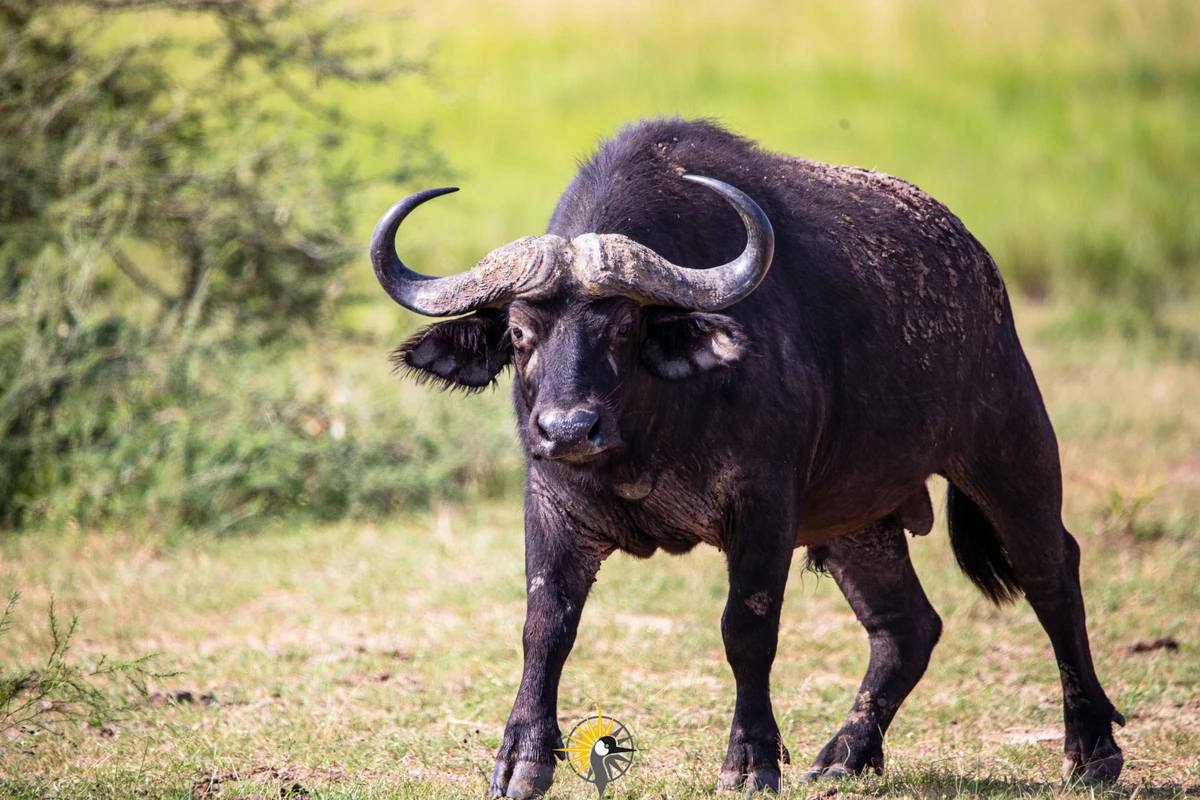One of Africa’s most formidable animals, the Cape buffalo stands out as a member of the “Big Five” for its strength, resilience, and unique social behavior. Often spotted in large herds or as solitary bulls, these robust animals are a symbol of the African savanna. Known for their unpredictable temperament, Cape buffaloes are a thrilling sight for safari-goers and a vital species in maintaining East Africa’s ecosystems. In this article, we’ll explore the fascinating world of the Cape buffalo, its behavior, and the top places in East Africa to witness these mighty creatures.
The Cape Buffalo
The Cape buffalo, also called the African buffalo, is the largest subspecies of African buffalo and is distinguished by its bulky frame, dark coat, and intimidating horns that curve downward and then up, creating a helmet-like shape. Adult males, known as bulls, can weigh up to 1,500 pounds and stand over five feet tall at the shoulder. Herds are typically led by dominant females, and their highly social nature makes their group interactions complex and captivating to observe.
Key characteristics of the Cape buffalo include:
- Powerful Build: Cape buffaloes have a stocky, muscular body built for strength, making them one of Africa’s most formidable animals.
- Unpredictable Temperament: Known for their unpredictable and aggressive nature, Cape buffaloes are quick to defend themselves and their herd from perceived threats, including predators.
- Herd Dynamics: Buffalo herds can number from a few individuals to several hundred, with members closely coordinating their movements and protecting one another.
- Keen Senses and Communication: Cape buffaloes use vocalizations, scent-marking, and body language to communicate, warning one another of danger and signaling changes in group movement.
Cape buffaloes have a strong bond with their herd, with dominant bulls often standing guard against predators like lions. Their formidable defenses, combined with a protective herd structure, make them one of the hardest animals for predators to take down.
Role in the Ecosystem
As grazers, Cape buffaloes play an essential role in shaping the African savanna. By consuming large amounts of grass, they help control vegetation and open up areas for other herbivores. This keeps the savanna ecosystem balanced and promotes biodiversity by preventing overgrowth in certain areas. Additionally, Cape buffaloes are a critical food source for top predators, such as lions, leopards, and hyenas, contributing to the health of East Africa’s predator populations.
Top Places to See Cape Buffalo in East Africa
For safari-goers keen to witness the Cape buffalo in action, East Africa’s renowned national parks and reserves offer prime locations. Here are some of the best places to encounter these impressive animals:
Serengeti National Park, Tanzania
One of the most famous wildlife destinations in the world, the Serengeti is home to vast herds of Cape buffalo. Known for its diverse wildlife, the Serengeti’s open plains make it an excellent place to watch buffalo herds in their natural environment. The sight of hundreds of buffaloes grazing or moving in unison across the golden plains is an unforgettable experience, particularly during the dry season when water sources draw large groups together.
Best Time to Visit: June to October, during the dry season, when water sources attract buffalo herds.
Maasai Mara National Reserve, Kenya
The Maasai Mara, a continuation of the Serengeti ecosystem, is renowned for its high density of predators and large populations of Cape buffalo. The reserve’s rolling hills, expansive grasslands, and regular encounters with predators make the Maasai Mara an exhilarating location to watch buffaloes in action. Here, buffaloes can often be seen challenging lions or simply grazing amidst other Big Five animals.
Best Time to Visit: June to October, which coincides with the Great Migration and optimal wildlife sightings.
Lake Nakuru National Park, Kenya
Famous for its flocks of pink flamingos, Lake Nakuru is also home to a significant Cape buffalo population. The lush greenery and surrounding acacia woodlands provide an ideal habitat for buffaloes, which can often be found along the shores of the lake. Lake Nakuru’s relatively small size and rich biodiversity make it an ideal spot for close encounters with these powerful animals.
Best Time to Visit: June to September, the dry season, when wildlife congregates around the lake.
Queen Elizabeth National Park, Uganda
Queen Elizabeth National Park’s varied landscapes and abundant wildlife make it a top safari destination in Uganda. Here, the Kazinga Channel serves as a gathering point for large buffalo herds, especially in the dry season. The park’s boat safaris provide a unique vantage point, allowing visitors to observe buffaloes along the water’s edge, mingling with hippos and elephants.
Best Time to Visit: June to September, when wildlife is most concentrated along water sources.
Tarangire National Park, Tanzania
Tarangire National Park, with its iconic baobab trees and high-density buffalo population, offers a distinct and rugged safari experience. During the dry season, herds of buffalo gather along the Tarangire River, which serves as the park’s lifeline. The contrast between the red earth and green riverbanks provides a scenic backdrop for watching buffaloes.
Best Time to Visit: June to October, the dry season, when buffaloes and other wildlife gather near the river.
Murchison Falls National Park, Uganda
Murchison Falls is Uganda’s largest national park, where the powerful Nile River cascades through a narrow gorge, creating a dramatic waterfall. The lush savanna plains around the riverbanks are home to substantial buffalo herds, especially near the Delta area. Murchison Falls offers a unique blend of riverine landscapes and savanna plains, making it an ideal place to spot buffaloes and other wildlife.
Best Time to Visit: December to February and June to September, during the dry seasons, for optimal wildlife viewing.
Selous Game Reserve (now Nyerere National Park), Tanzania
This vast and less-traveled wilderness area offers a remote safari experience with significant buffalo populations. Here, visitors can watch large buffalo herds grazing on open plains or cooling off in the Rufiji River. Nyerere National Park’s remoteness and range of safari options, including boat safaris, provide intimate encounters with Cape buffaloes and other wildlife in a tranquil environment.
Best Time to Visit: June to October, the dry season, when wildlife is concentrated near water sources.
Conservation Efforts and How You Can Support
Cape buffaloes, while not as endangered as other African species, still face threats from habitat loss, disease, and human-wildlife conflict. Conservation organizations are actively working to protect their habitats, mitigate human-buffalo conflicts, and control disease outbreaks within buffalo populations. By supporting eco-friendly tourism operators and participating in conservation-focused safari experiences, visitors can play a role in ensuring the long-term survival of Cape buffaloes in East Africa.
Many East African parks and reserves rely on tourism revenue to fund anti-poaching units, disease control measures, and conservation projects that benefit not only buffaloes but also a wide range of wildlife. Visitors who choose responsible tourism operators help protect these valuable habitats, support local communities, and promote a balanced ecosystem.
Planning Your East African Safari for Cape Buffalo Encounters
Encountering a herd of Cape buffalo on an East African safari is a powerful experience, one that showcases the animal’s strength, social complexity, and vital role in the ecosystem. Whether it’s the dramatic backdrop of the Serengeti, the lush landscape of Queen Elizabeth National Park, or the wild beauty of Nyerere National Park, East Africa offers remarkable opportunities to observe these animals in their natural habitat.
For travelers interested in witnessing the Cape buffalo, planning a safari with a conservation-minded operator is essential. Not only will this enhance your wildlife experience, but it also supports the parks and local communities that protect these iconic animals. So, pack your bags, grab your camera, and get ready to experience the incredible power and presence of the Cape buffalo in East Africa.









